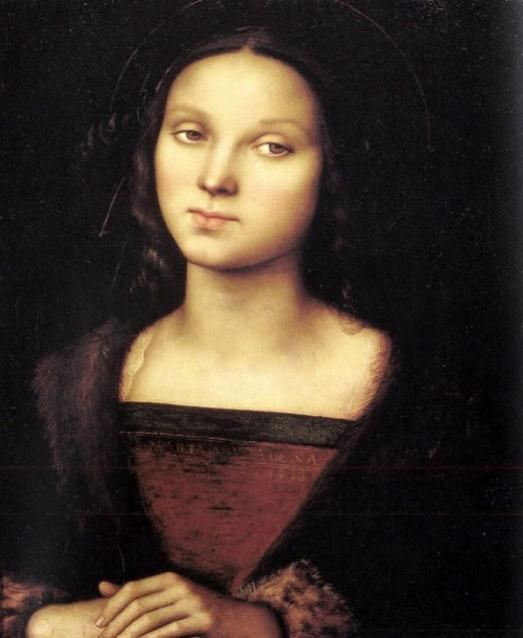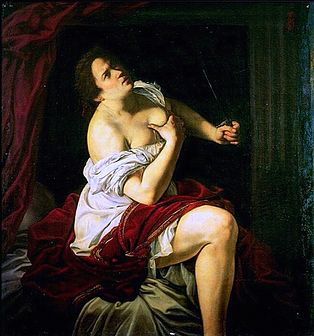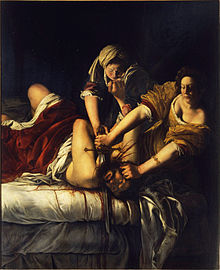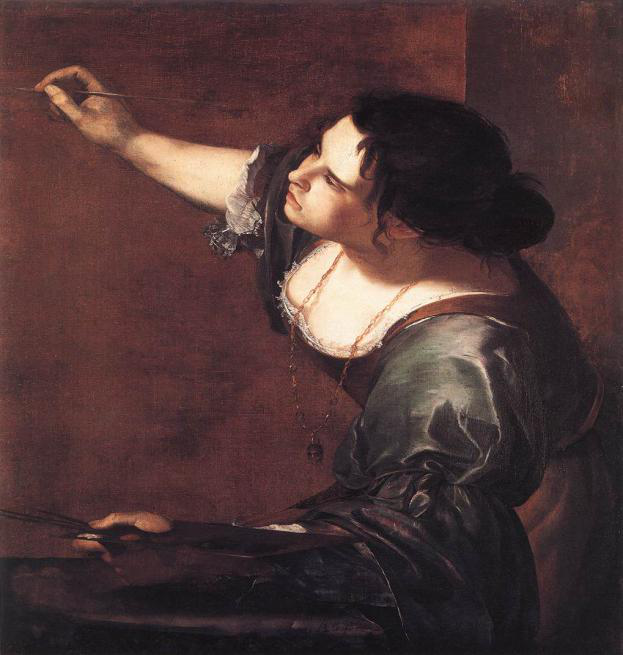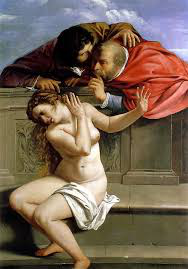Artemisia Gentileschi was an early Italian painter of the Baroque era, the first woman elected to the Academy of Painting in Florence and the only female follower of Caravaggio, whom she worked with in Italy in the early 17th century. She was one of the earliest female painters to enter into the male-dominated artistic community of the time. Her innovative compositions in art and focus on Biblical heroines set her apart from her male contemporaries and have led to the celebration of Gentileschi as a painter with a uniquely female perspective. For many years she was regarded as a curiosity. Today she is regarded as one of the most progressive and expressive painters of her generation.
Biography
Artemisia Gentileschi was born on 8 July 1593 in the family of the well-known in Rome 30-year-old artist Orazio Gentileschi and his 18-year-old wife, Prudentia. Her mother died during childbirth when Artemisia was 12 years old. Her father soon found a replacement for his wife, and Artemisia began to learn the basics of the artist’s skill.
As a young girl, she served as an apprentice to her father, learning the skills of a professional painter. Her drawings were excellent in accuracy. She made her first well-known work at the age of 17, “Susanna and the Elders.”
Being a girl, she was not accepted into any painting academy thus her father hired his colleague, the landscape painter Agostino Tassi, to give lessons for Artemisia. In 1612, Tassi raped Gentileschi, an event now inextricably linked to her name. After a lengthy and painful trial, Tassi was found guilty of rape and jailed for eight months. This event had a tremendously negative impact on Artemisia Gentileschi and her reputation, and the artist suffered from gossip that branded her a promiscuous woman.
During some time, Artemisia even waited for Tassi to offer her a marriage – this option still looked better than public humiliation. But the marriage did not take place, as it turned out that Agostino Tassi was already married, but he “forgot to report.”
Artemisia’s father quickly arranged marriage, in order to save his daughter’s honor. She married to Florence painter Pierantonio Stiattesi, and the couple moved to Florence, where Artemisia Gentileschi became a celebrated artist. She was accepted into a painters’ academy and befriended Galileo Galilei. Here she worked under the patronage of Cosimo II Medici.
In the following decades, she lived in Rome, Venice, Naples, and London, where she worked as a painter for the court of Charles I alongside her father.
In the Neapolitan period, the artist first received an order for a fresco painting of the church – in the town of Pozzuoli near Naples. The death of her father in 1939 and the English civil war, led Gentileschi to leave the country. Then she returned to Naples, where he lived until his death. While there, she painted her “Self-Portrait as the Allegory of Painting.” During her life, she painted several different self-portraits. It is not known exactly when she died. It is thought that she was one of many victims of the great pestilence that struck Naples in 1656.
Art historian Charles Moffat believes Artemisia may have committed suicide, which would explain why the cause of her death was not recorded.
While Gentileschi was a recognized painter in her lifetime, after her death a great deal of her work fell into obscurity and was often attributed to other followers of Caravaggio or to her father.
Key Ideas in painting
The picturesque manner of Artemisia was not so much influenced by her father Orazio Gentileski as the all-encompassing impact of Caravaggio, manifested both stylistically and thematically. Her paintings combine bright, dramatic effects, expressive cut-off contrasts, and rich colors.
Due to personal circumstances (Artemisia experienced a shameful lawsuit related to sexual violence), the main theme of Gentileschi ‘s creativity was the female ability to defend one’s own dignity. For a woman at the beginning of the seventeenth century, Artemisia being a painter represented an uncommon and difficult choice, but not an exceptional one.
The famous Italian art critic of the twentieth century Roberto Longhi called her ” the only woman in Italy who ever knew about painting, coloring, drawing, and other fundamentals.” Longhi argued that of the 57 famous paintings of Artemisia Gentileschi, at least 49 depict women, like or even equal to men.
Artemisia writes mostly women in her works. In kind, her own body often serves for them. They are always very strong, dominant women, ruling their own destiny. Gentileschi often chose historic and biblical subjects in her drawings that featured a female protagonist: Susanna, Bathsheba, Esther, Judith, etc. Other repetitive plots of famous paintings by Artemisia are Lucretius, Cleopatra, queen of Savsky, that is, glorified women of the past.
Famous paintings made by Artemisia Gentileschi
Among famous works of Artemisia Gentileschi are “Samson and Delilah,” “Virgin and Child,” “Lucretia,” Judith Slaying Holofernes,” “Madonna and Child,” “Jael and Sisera.”
Using lustrous colors and chiaroscuro soon after the trial, Artemisia Gentileschi painted her most famous work “Judith Slaying Holofernes” (1612-1613), where her life experiences were expressed. The artwork is remarkable not only for its technical proficiency but for the original way in which Gentileschi portrays Judith, who had long been a popular subject for art.
Artemisia will repeat this story many times, outliving painful experiences. Violence against a woman will become the theme of her other artwork like “Susanna and the Elders.” And the inevitable continuation of this topic will be violence – the bloody and terrible female revenge in work “Jael and Sisara.”
Artemisia painted many portraits and famous works during her life and quickly surpassed her father’s fame.
Lucretia
Virgin and Child
Judith Slaying Holofernes
Self-portrait
Susanna and the elders
So, in the history of world Baroque art, Artemisia was an author who was not only talented enough to achieve glory and recognition despite all social and discriminatory conditions in her biography. This is a woman who was able to loudly say “we are not worse” and get approval officially, at the Academy of Arts level.




